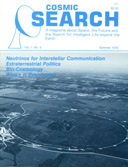![[NAAPO Logo]](../../Images/NAAPOsm.jpg) North American AstroPhysical Observatory (NAAPO)
|
|
Computers and the Garden Path
By: Robert S. Dixon
While carrying out a recent computerized literature search for published material about SETI, a hitherto unknown technical article title was found which sounded very promising: "Doppler-independent Selective Heterodyne Radiometry for Detection
of Remote Species." Well now, isn't "Detection of Remote Species" what SETI is all about? And after all, don't most actual searches use radio telescopes whose receivers are "radiometers" which are "selective" and use the "heterodyne" method? And doesn't the motion of the Earth and the other species' planet generally cause "Doppler" frequency shifts that make it difficult to predict their exact frequency? Wouldn't it be great if somebody had finally figured out a neat way to get around this difficulty by making his receiver "Doppler-independent?"
With great anticipation, a mad dash was made to the library to look up this new article that was just sure to revolutionize SETI. A glance at the illustrations was encouraging. A skim through the abstract was vaguely troubling. A careful reading of the text
was devastating. Alas, the article was not about SETI at all. The computer and the English language had conspired to lead us astray.
What was the article really about? Write to COSMIC SEARCH and give us your best guess. (No fair looking up the article yourself). We'll publish the guesses and the correct answer later.
—Robert S. Dixon
P.S. A second careful reading of the text suggested that maybe after all....
|

